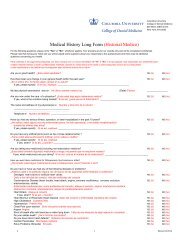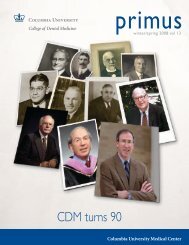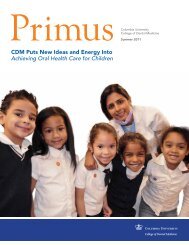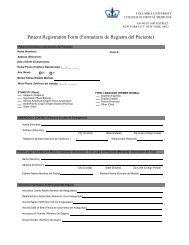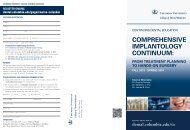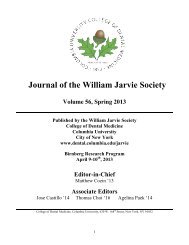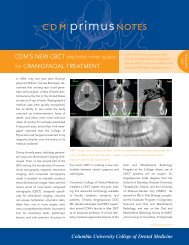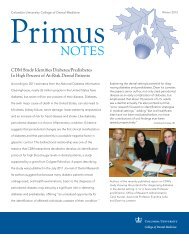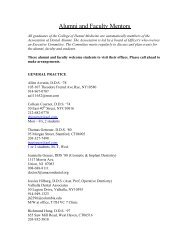Fall 2006 - College of Dental Medicine - Columbia University
Fall 2006 - College of Dental Medicine - Columbia University
Fall 2006 - College of Dental Medicine - Columbia University
Create successful ePaper yourself
Turn your PDF publications into a flip-book with our unique Google optimized e-Paper software.
Seeking Scientific Evidence <strong>of</strong>Bisphophonates have been used for almost 20 yearsin preventing and treating postmenopausal andsteroid-induced osteoporosis, Paget’s disease <strong>of</strong>bone, hypercalcemia <strong>of</strong> malignancy, and multiplemyeloma, and in preventing bone metastases associatedwith breast, prostate, lung, and other s<strong>of</strong>t tissuetumors. Bisphosphonates strengthen bone and preventfractures by inhibiting bone loss (resorption) inskeletal long bones, but may act somewhat differentlyon the jaw bones, interfering with theosteoblast/osteoclast balance important to boneremodeling. Recent research has related the biochemicalinteraction that makes BPs very effectiveinhibitors <strong>of</strong> bone resorption to the chemical structureand molecular action <strong>of</strong> inorganic phosphate,which regulates bone metabolism by initiatingosteoclast destruction. BPs are currently approvedfor the treatment and prevention <strong>of</strong> skeletal-relatedevents in breast cancer patients with bone metastases,as well as in cases <strong>of</strong> prostate, lung, and others<strong>of</strong>t-tissue cancers. Breast cancer accounts forapproximately 30 percent <strong>of</strong> all new cancer cases inwomen, half <strong>of</strong> whom develop bone metastases,with 40 to 70 percent experiencing bone pain,pathological fracture, or spinal cord compression.Associate Pr<strong>of</strong>essor <strong>of</strong> ClinicalDentistry Regina Landesberg,DMD, PhD, is an oral andmaxill<strong>of</strong>acial surgery researchscientist at CDM.IN 2003, A LETTER TO THE JOURNAL OF ORALAND MAXILLOFACIAL SURGERY DESCRIBED ASTILL UNCOMMON CONDITION, OSTEO-NECROSIS OF THE JAW (ONJ), AS “AGROWING EPIDEMIC.” THE CONCLUSIONWAS BASED ON THE CASES OF SEVERALDOZEN CANCER PATIENTS WHO HADBEEN RECEIVING INTRAVENOUS BISPHOS-PHONATE THERAPY AND PRESENTEDWITH “PAINFUL BONE EXPOSURE [IN THEJAW] ... [THAT WAS] UNRESPONSIVE TOSURGICAL OR MEDICAL TREATMENTS.”Investigators at the <strong>College</strong> <strong>of</strong> <strong>Dental</strong> <strong>Medicine</strong>(CDM) have been awarded one <strong>of</strong> the first NIH-supportedgrants to study the incidence and risk factorsfor developing osteonecrosis <strong>of</strong> the jaw in cancerpatients undergoing bisphosphonate therapy to preventbone metastases. Associate Pr<strong>of</strong>essor <strong>of</strong> ClinicalDentistry in the Division <strong>of</strong> Oral and Maxill<strong>of</strong>acialSurgery Regina Landesberg, DMD, PhD, andPr<strong>of</strong>essor and Director <strong>of</strong> the Division <strong>of</strong> OralBiology and the Center for Clinical Research inDentistry John T. Grbic, DMD, MS, MMSc, are coinvestigatorsfor the two-year study grant.Our knowledge <strong>of</strong> ONJ comes primarily from casereports that are limited by the lack <strong>of</strong> a consistentdefinition for ONJ. ONJ is characterized by anexposure <strong>of</strong> the jaw bone that fails to heal and is<strong>of</strong>ten found at the site <strong>of</strong> a previous invasive surgicalprocedure, such as an extraction. Other symptomsinclude: painful, swollen, or infected gums; mouthsores that heal poorly; loose teeth; numbness andtingling in the lips or jaw, or a “heavy” feeling jaw.Such a lesion may, however, be painless and notapparent to the patient. Because these case reportslacked the scientifically based examination necessaryto draw accurate conclusions on the concomitantrisk factors, predictive markers, etiology, and pathognesison ONJ, Drs. Landesberg and Grbic, workingwith colleagues from the <strong>College</strong> <strong>of</strong> Physicians &Surgeons as well as the Mailman School <strong>of</strong> PublicHealth, have designed a clinical study to investigatethese and other variables that could contribute tothe condition.16primus<strong>2006</strong>



